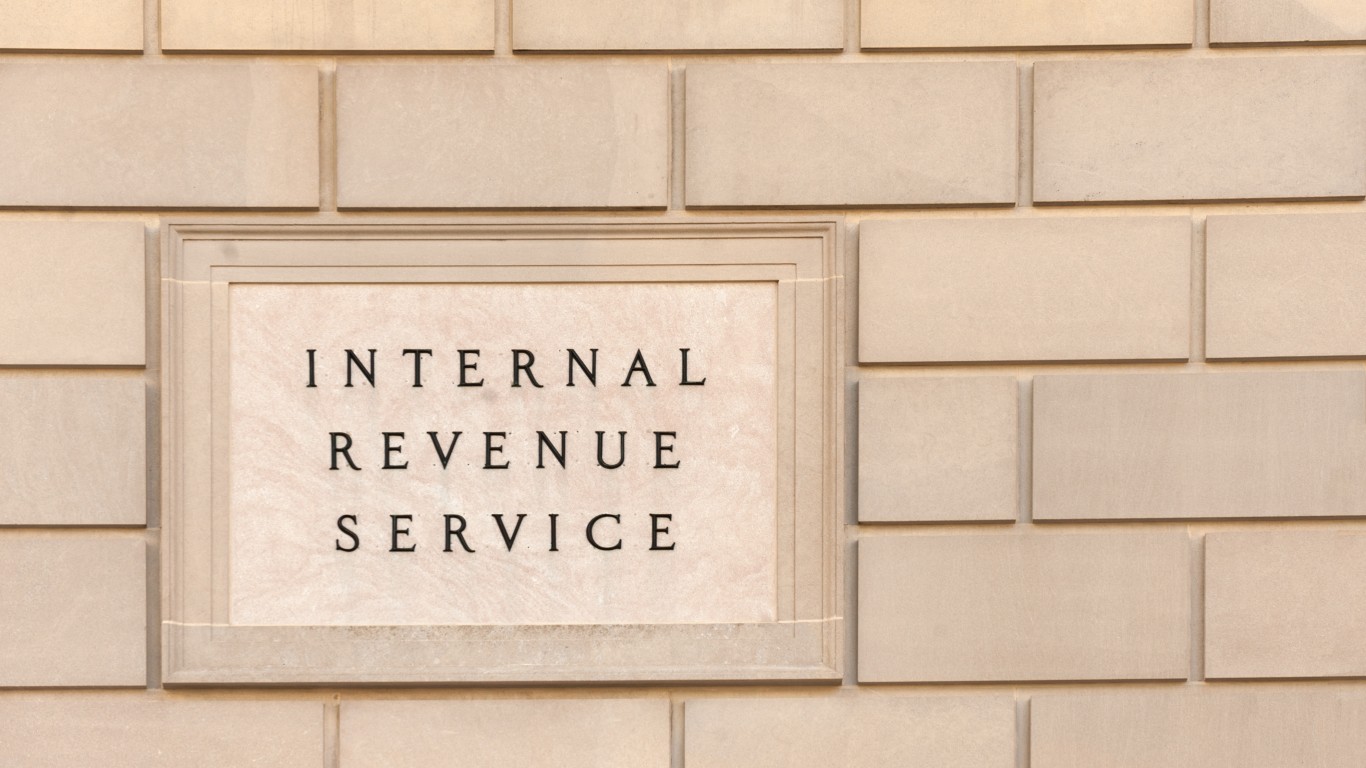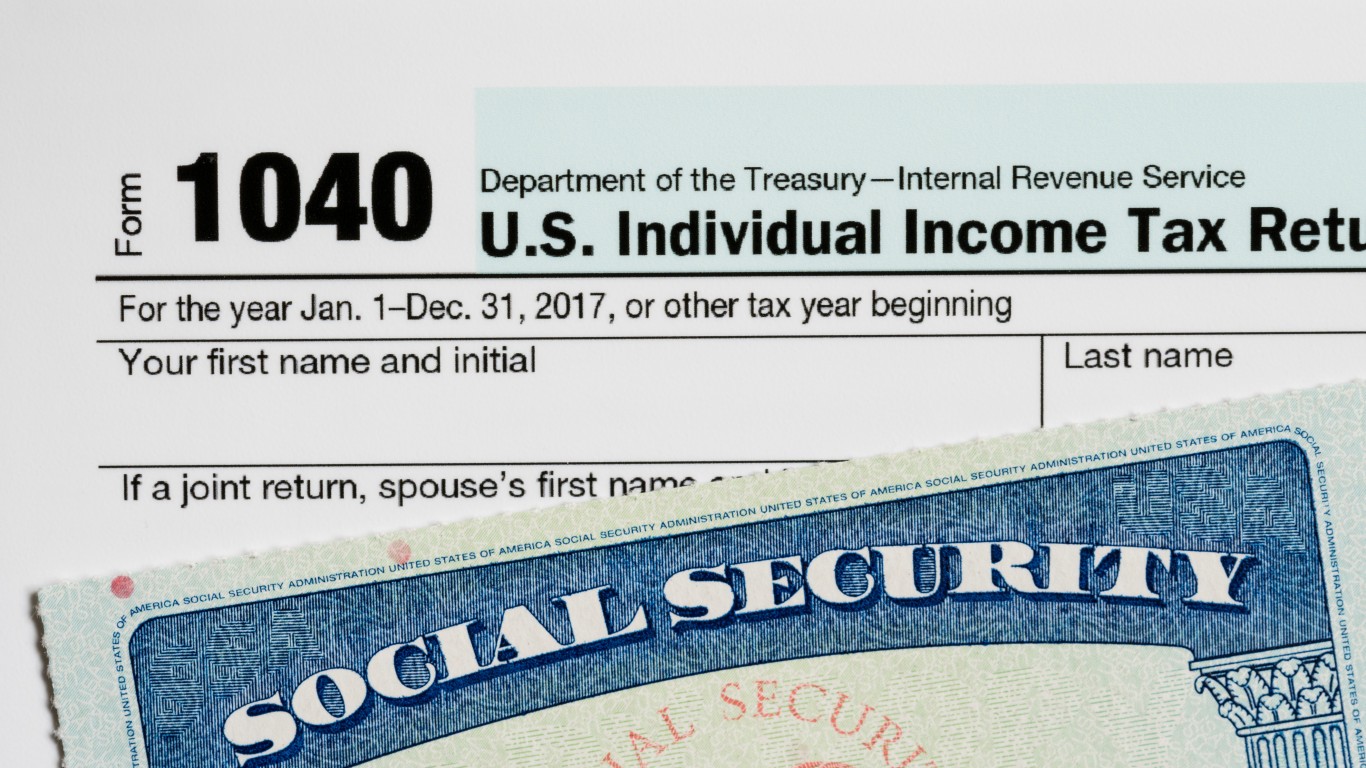
With the COVID-19 pandemic shaking up nearly every aspect of life in 2020 and into 2021, the Internal Revenue Service has opted to push back the federal tax filing deadline. Instead of April 15, federal taxes should now be completed by May 17.
Despite the extra month to complete the federal tax returns, people might still make some common mistakes that could cause their filings to be audited. The IRS audits around 300,000 filings each year, but double-checking your filing and avoiding some simple mistakes could help ensure that your return does not land on the dreaded audit list.
To determine the most common tax mistakes, 24/7 Wall St. reviewed several of the IRS’s annual lists of common errors made on tax returns.
Nearly 73% of all taxes in 2019 were filed electronically, including more than 89% of all individual returns. Filing electronically is a good way to avoid many of the most common errors, which include misspellings, unsigned forms, and incorrectly calculated figures. However, some transcription errors can be made even more easily by accidentally typing in the wrong number.
With the federal government extending the tax filing deadline, most states chose to do the same. Many states pushed their filing dates to May 17, like the federal government, though a handful pushed it into the summer. These are the states where you’ll pay the most in taxes.
Click here to see 19 of the most common tax mistakes.

19. Failure to make a copy of signed return
It is important to make a copy of signed tax returns as many common types of loans, including mortgages and student loans, require past tax information. If filers are missing copies of previous returns but need one, the IRS can send a copy for $50 each. Keeping copies of your returns on record can also be very handy in the event of an audit or if you need to amend a return.
[in-text-ad]

18. Failure to double-check routing and account numbers
While this may seem obvious, it is one of the more common mistakes Americans make when filing their taxes. Banking and routing numbers with errors can make it difficult for the IRS to issue a refund via direct deposit and can delay your refund by months.

17. Failure to include all necessary information on checks or money orders
If filers owe the IRS money and they aren’t filing electronically, they must include a payment — check or money order payable to the “United States Treasury” — that includes name, address, social security number, daytime telephone number, tax form, and the tax year on the payment.

16. Sending in return with inadequate postage
If you are not one of the majority of Americans who file their taxes electronically, make sure you have the correct postage on the envelope when you send in your taxes. Otherwise, the postal service will return it to you, putting you at risk of missing the new July 15 filing deadline.
[in-text-ad-2]

15. Sending your return to the wrong IRS office
There are different IRS office addresses for specific regions and types of tax documents. If you send your return to the wrong IRS office, potentially delaying your refund, you are not alone. Using the wrong IRS address is one of the most common mistakes Americans make each year.

14. Arranging tax documents in the incorrect order
Errors on your tax return, including something as simple as failure to organize documents in sequential order, can result in a delayed refund. Make sure to use the sequence numbers on the documents to maintain the correct order.
[in-text-ad]

13. Failure to attach 1099-R forms
1099-R forms are used to claim retirement plans, pensions, and annuities withheld over the course of the year, or used to report funds that were withdrawn from an IRA. Some of these funds can be treated as income, bumping filers into a higher bracket. Failing to report these payments and withdrawals can result in an audit.

12. Failure to include all W-2 forms
The IRS requires taxpayers to include an official copy of their W-2 forms from their employer or employers, if they have more than one job. Wages and withholdings noted on these forms must be combined and reported on the tax return.

11. Failure to use Identity Protection PIN (if applicable)
An IP PIN is a six-digit number assigned to eligible taxpayers to help protect against fraudulent use of their social security number. While not everyone is eligible for a pin, those who are must follow separate tax filing instructions specific to IP PIN holders. Visit this page on the IRS website for details on who is eligible, which localities are using them, and how to get yours if you believe you should have one.
[in-text-ad-2]

10. Failure to sign and date return
One of the simplest and most important steps while filing is signing and dating the return — and have your spouse sign and date if you are filing jointly. Unsigned and undated returns cannot be accepted and will be sent back for signing.

9. Using incorrect column from the tax tables form
If you are calculating your own taxes, you will likely need to refer to the 1040 Tax Tables document to make the calculations. If you are not looking in the column applicable to you, however, you could easily miscalculate. While this may sound obvious, the IRS reports it as one of the most common mistakes.
[in-text-ad]

8. Failure to claim the correct deduction if over 65 or blind
Those who are blind or over 65 are entitled to specific deductions, but filers must use a chart found on the 1040 or 1040A forms to determine the correct deduction. According to the IRS, people claiming these deductions frequently misuse the tables and list the wrong amount.

7. Failure to enclose negative amounts in brackets
This common mistake can have potentially serious consequences. If negative figures are not noted in brackets, they may be misinterpreted by the IRS as positive numbers and result in additional taxes.

6. Incorrectly calculating deductions and credits
Tax deductions, such as charitable donations, effectively reduce taxable income, while tax credits directly reduce taxes owed. Miscalculations could result in overpaying the IRS.
[in-text-ad-2]

5. Entering income on the wrong lines
One simple and easily avoidable mistake that will certainly raise eyebrows at the IRS is income entered in the wrong box.

4. Failure to correctly list all dependents
Taxpayers must list all names and taxpayer identification numbers for each person listed on the return. If the tax filer is using social security numbers, the corresponding names must appear exactly as they do on the corresponding social security card.
[in-text-ad]

3. Failure to correctly declare exemptions
In order to benefit from spousal and dependency exemptions, the IRS requires certain information. For spousal exemptions, both you and your spouse’s age as well as the gross income amounts must appear. For dependents, taxpayers must disclose their relationship to the dependent and the amount of support provided.

2. Choosing the incorrect filing status
Filing status is used to determine certain filing requirements, deductions, and credit eligibility. Despite being essential to correctly filing taxes, choosing the incorrect filing status remains a relatively common mistake among American taxpayers. The five filing statuses are: single, married filing jointly, married filing separately, head of household, and qualifying widow(er) with dependent child or children.

1. Tax return is illegible
It should come as no surprise that if the IRS cannot read your name, taxpayer ID number, or address, agents cannot process your return. Still, illegible penmanship is a common problem among those who do not file electronically.
Is Your Money Earning the Best Possible Rate? (Sponsor)
Let’s face it: If your money is just sitting in a checking account, you’re losing value every single day. With most checking accounts offering little to no interest, the cash you worked so hard to save is gradually being eroded by inflation.
However, by moving that money into a high-yield savings account, you can put your cash to work, growing steadily with little to no effort on your part. In just a few clicks, you can set up a high-yield savings account and start earning interest immediately.
There are plenty of reputable banks and online platforms that offer competitive rates, and many of them come with zero fees and no minimum balance requirements. Click here to see if you’re earning the best possible rate on your money!
Thank you for reading! Have some feedback for us?
Contact the 24/7 Wall St. editorial team.
 24/7 Wall St.
24/7 Wall St.
